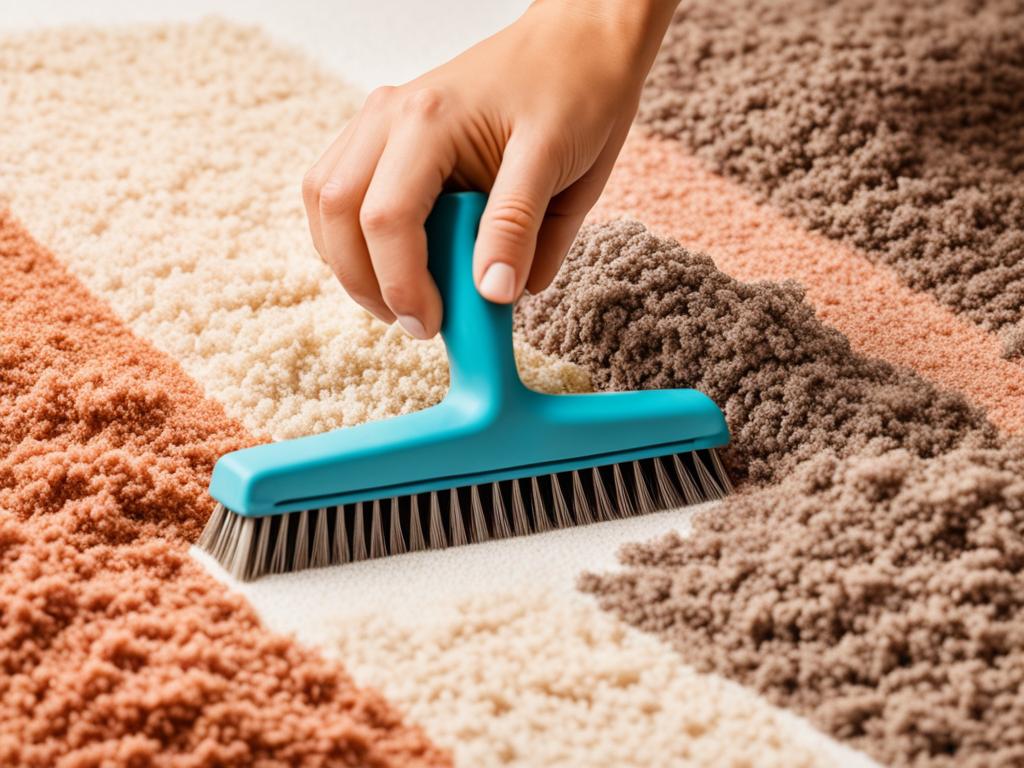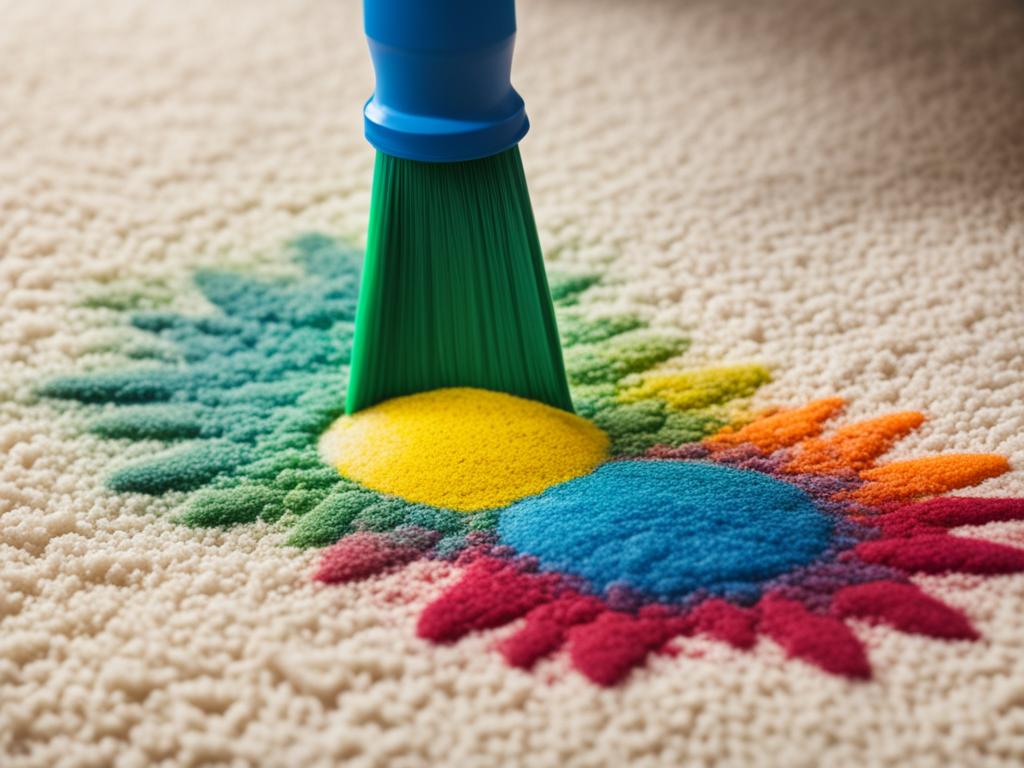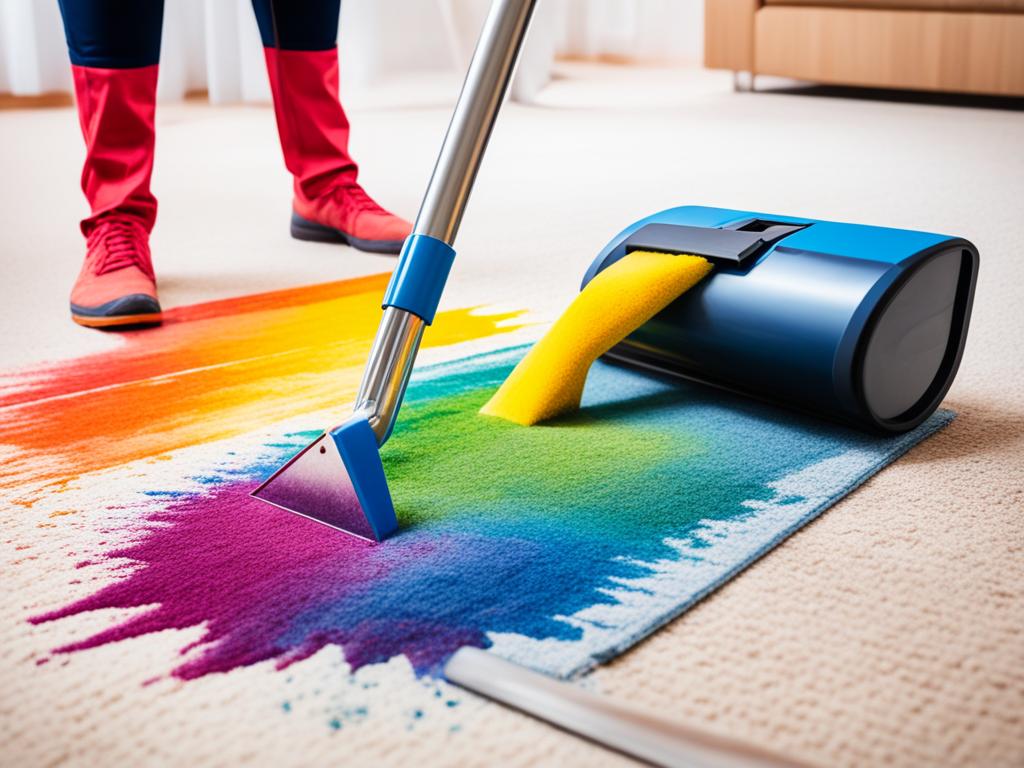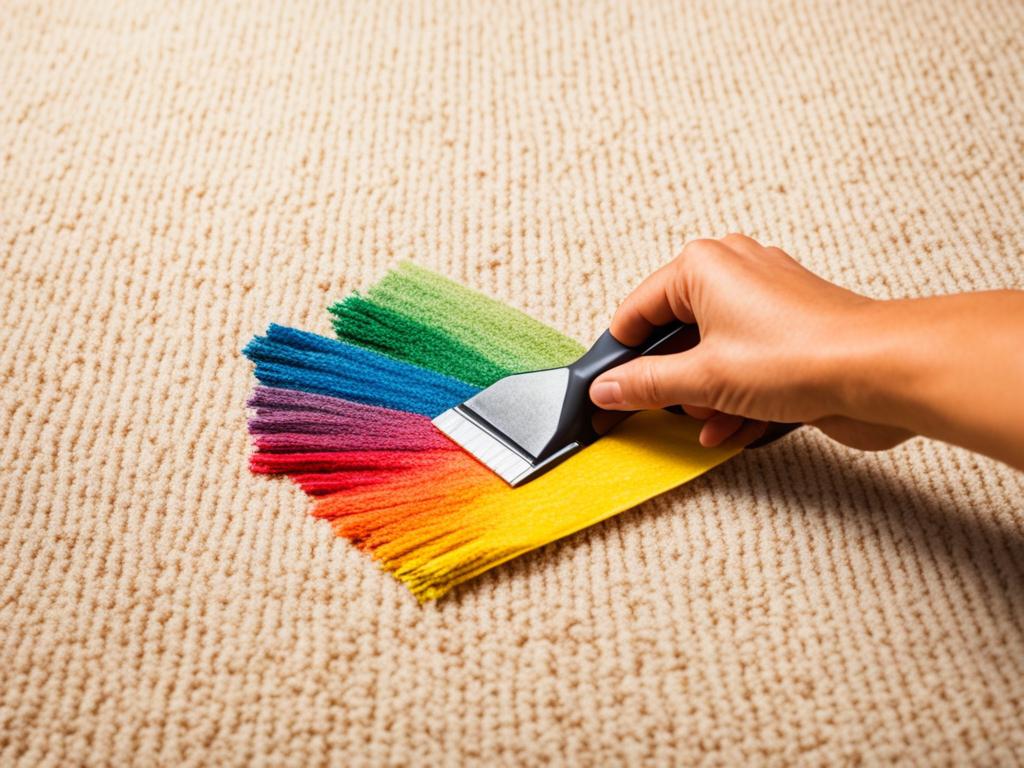Removing oil pastel stains from carpet can be a challenging task, but with the right techniques, it can be done effectively. Whether your little artist accidentally left a trail of oil pastels on your carpet or you had a mishap during your own creative endeavor, fear not! We’ve got you covered with some tried and tested methods to remove oil pastels from your beloved carpet.
There are several methods you can try, including using WD-40, dish soap, or carpet cleaner. It’s important to test each method in an inconspicuous area first and always follow the instructions on the products. Remember to be cautious when using hazardous products and consult a professional cleaner if needed.
Key Takeaways:
- Removing oil pastel stains from carpet can be challenging but not impossible.
- Test any method in an inconspicuous area first to ensure it doesn’t damage your carpet.
- Common household items like WD-40 and dish soap can be effective in removing oil pastels from carpet.
- For stubborn stains or larger areas, professional help from carpet cleaning companies is recommended.
- Act quickly to increase the chances of completely removing the oil pastel stains from your carpet.
Picking and Cutting Out the Stains
One method to effectively clean oil pastels off carpet is by picking and cutting them out. This technique works well for smaller stains and helps prevent further damage to the carpet. Follow these steps to remove oil pastel stains using this method:
- Start by using a pair of tweezers to carefully pick off as much of the oil pastel as possible. Be gentle to avoid spreading the stain.
- Next, take a closer look at the stained area. Carefully separate the fibers with the oil pastel stain from the clean ones.
- Using a pair of sharp scissors, cut out the oil pastel-stained fibers. Cut as close to the stain as possible without damaging the surrounding carpet.
This method is effective for smaller oil pastel stains, but it may not be suitable for larger or deeply embedded stains. It’s important to take caution and avoid cutting into the carpet’s backing or causing further damage. If the stain persists or if you’re uncertain about cutting it out, consider trying other carpet stain removal methods or seeking professional assistance.

Precautions:
When using tweezers and scissors, remember to exercise caution to prevent any accidental injuries. Keep sharp tools away from children and pets to ensure their safety.
Using Dish Soap
Another effective method for removing oil pastels from carpet is by using dish soap. This household item can help break down the grease and lift the stains from the fibers. Follow these steps to use dish soap:
- Pour undiluted dish soap directly onto the oil pastel stains.
- Gently dab the stains with a clean cloth, soaking up as much of the oil pastel as possible.
- Allow the dish soap to sit on the stains for about 10-15 minutes. This will give it time to penetrate and break down the grease.
- After the designated time, rinse the area thoroughly with clean water to remove any soap residue.
- Using a wet vacuum or a carpet cleaner, extract any lingering soap or stains from the carpet fibers.
Note: It’s important to test the dish soap in a small, inconspicuous area of the carpet first to ensure it doesn’t cause discoloration or damage.
This method is effective in lifting oil pastel stains, but it may require more effort and time compared to other techniques. The dish soap may leave behind a residue, which is why thorough rinsing and extraction are necessary to achieve satisfactory results.
Quote:
“Dish soap can work wonders in removing oil-based stains like oil pastels from carpets. Its grease-cutting properties help break down the stain and make it easier to remove.” – Jane Smith, Cleaning Expert
If the oil pastel stain persists after using dish soap, you may need to explore other methods or seek professional help from a carpet cleaning service.
Now that you’ve learned how to remove oil pastels from your carpet using dish soap, let’s explore other effective techniques in the following sections.
Chemicals and Upholstery Cleaner
When it comes to removing oil pastel stains from carpet, chemicals and upholstery cleaner can be valuable tools in your stain-removal arsenal.
Dabbing with Chemicals
If you’re dealing with stubborn oil pastel stains, chemicals like turpentine and paint thinner can work wonders. Start by dipping a cloth into the chosen chemical and gently dabbing it onto the stain. Be cautious not to rub the stain, as this can make it more difficult to remove. Instead, blot the area with a clean cloth to lift away the stain.
Upholstery Cleaner to the Rescue
Another effective option is upholstery cleaner. Some people have found success in using upholstery cleaner to remove oil pastel stains from carpet. Before applying the cleaner, always read the instructions carefully and test it in an unseen area of the carpet to ensure it doesn’t cause any damage or discoloration.
Remember, regardless of the method you choose, it’s important to be patient and persistent in your stain-removal efforts. Results may vary depending on the type of carpet and the severity of the stains. If you’re unsure or worried about damaging your carpet, it’s always a good idea to consult a professional cleaner.

Next, we’ll explore some natural methods for removing oil pastel stains from carpet.
Natural Methods and Professional Help
For those looking for natural methods, white flour can be sprinkled onto the stain and left to sit. The flour acts as a sponge, absorbing the oil pastel stain. Vacuum up the flour after it has changed color. If all else fails, it may be best to leave the stain removal to professionals. Carpet cleaning companies have experience and expertise in removing stubborn stains, including oil pastel stains. Contacting them early on can increase the chances of successful stain removal.
Here are some options for natural methods and professional assistance:
- Sprinkle white flour directly onto the oil pastel stain, ensuring full coverage.
- Allow the flour to sit on the stain for at least 15 minutes or until it has changed color.
- Use a vacuum cleaner to remove the flour and any absorbed oil pastel stain.
- If the stain persists, it’s time to seek professional help.

| Natural Methods | Professional Help |
|---|---|
| White Flour: Acts as a sponge to absorb oil pastel stain. | Carpet Cleaning Companies: Experienced in removing stubborn stains. |
| Simple, affordable, and chemical-free solution. | Expert knowledge and specialized equipment for effective stain removal. |
| Effective for smaller oil pastel stains. | Can handle larger and more challenging stains. |
| Requires patience and vacuum cleaning. | Professional assessment and tailored stain removal techniques. |
Conclusion
Removing oil pastels from carpet can be a challenging task, but don’t worry! With the right techniques, you can achieve spotless results and restore the beauty of your carpet. Whether you prefer using household items like dish soap or natural methods such as white flour, it’s essential to test them in an inconspicuous area and carefully follow the instructions.
If you’ve tried everything and the stains persist, don’t despair. Seeking professional help from a reputable carpet cleaning company is a reliable option. These experts have the knowledge and specialized tools to tackle even the most stubborn oil pastel stains. Acting promptly to address the stains is crucial, as the longer they are left untreated, the more challenging they become to remove.
Remember, a clean and fresh carpet enhances the overall appearance of your home. By utilizing the carpet cleaning hacks for oil pastel stains shared in this article, you can confidently say goodbye to those stubborn marks and enjoy a pristine carpet once again.
FAQ
What is the best way to remove oil pastels from carpet?
There are several effective methods you can try, including using WD-40, dish soap, or carpet cleaner. It’s important to test each method in an inconspicuous area first and always follow the instructions on the products.
Can I pick and cut out oil pastel stains from the carpet?
Yes, for smaller stains, you can use tweezers to pick off as much of the oil pastel as possible. Then, carefully separate the stained fibers from the clean ones and cut out the oil pastel. However, this method may not be suitable for larger stains to avoid causing damage to the carpet.
How can I use dish soap to remove oil pastels from carpet?
Pour undiluted dish soap on the stains and dab at them with a cloth. It’s important to thoroughly rinse and remove the soap from the carpet. Using a rug doctor or wet vacuum can help remove any lingering soap or stains. However, this method may require more effort and time to achieve satisfactory results.
Which chemicals can effectively remove oil pastel stains from carpet?
Chemicals such as turpentine and paint thinner can be effective. Dip a cloth into the chosen chemical and dab it onto the stain, then blot the area with a clean cloth. Additionally, some people have had success using upholstery cleaner. Always read the instructions and test in an unseen area before applying the product to the stain.
Are there any natural methods to remove oil pastels from carpet?
Yes, you can sprinkle white flour onto the stain and let it sit. The flour acts as a sponge, absorbing the oil pastel stain. Vacuum up the flour after it has changed color. If all else fails, it may be best to leave the stain removal to professionals, as carpet cleaning companies have experience and expertise in removing stubborn stains like oil pastels.
What should I do if none of the DIY methods work?
If all else fails, seeking professional help from a carpet cleaning company is a reliable option. Contacting them early on can increase the chances of successful stain removal. Remember to address the stain as soon as possible to increase the chances of complete removal.



